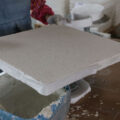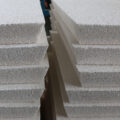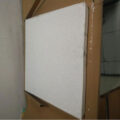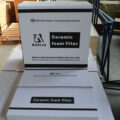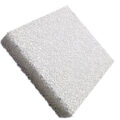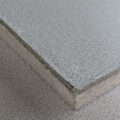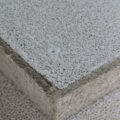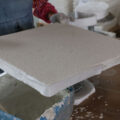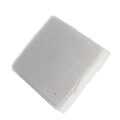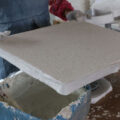There is a foam ceramic filter manufacturing process for manufacturing ceramic foam filters for casting. The polymer sponge method, which will be described in more detail here, creates an open-pore structure by impregnating a polymer sponge with a ceramic slurry, and then burning it to leave the porous ceramic. Direct foaming methods can produce open-cell and closed-cell structures, with foam structures being more common.
In this method, a chemical mixture containing the required ceramic components and organic materials is processed to release gas. Then, bubbles are generated in the material to make it foam. The resulting porous ceramic material is then dried and fired. For honeycomb or honeycomb structures, a plastic forming method called extrusion is used, in which a mixture of ceramic powder and additives is pressed into a forming die. The honeycomb structure can also be produced using pressing methods.

Foam Ceramic Filter Manufacturing Process
Choose Sponge
First, you must choose a polymer sponge with suitable properties. The pore size of the sponge determines the pore size of the final ceramic after firing. It must also be able to recover its original shape and be converted into gas at a temperature lower than that required to fire the ceramic. Polymers that can meet these requirements include polyurethane, cellulose, polyvinyl chloride, polystyrene, and latex. The typical polymer sponge has a size range of 3.94-39.4 inches (10-100 cm) wide and 0.349-3.94 inches (1-10 cm) thick.
Prepare Mud
After the sponge is selected, a slurry is made by mixing ceramic powder and additives in water. Ceramic powder usually consists of particles with a size of less than 45 microns. The amount of water can be 10-40% of the total weight of the slurry.
Dip the Sponge
Before immersion, the sponge is usually compressed to remove air, sometimes using a mechanical plunger multiple times. Once it is immersed in the mud, the sponge can expand and the mud fills the openings. The compression/expansion step can be repeated to obtain the desired density.
Remove Excess Slurry
After infiltration, 25-75% of the slurry must be removed from the sponge. This is done by compressing the sponge between the planks, centrifuging or by preset rollers. The gap between the rollers determines the amount of removal. Sometimes, because the foam is still soft, the impregnated foam undergoes another forming step.
Drying
The infiltrated sponge is then dried using one of several methods-air drying, oven drying or microwave heating. Air drying takes 8 to 24 hours. Oven drying is performed between 212-1292°F (100-700°C) and is completed in 15 minutes to 6 hours.
Burn the Sponge
Another heating step is required to remove organics from the slurry and burn out the sponge. This occurs in air or inert gas at a temperature between 662-1,472°F (350-800°C) for 15 minutes to 6 hours, and the heating rate is slow and controlled to prevent the ceramic structure from cracking. The temperature depends on the temperature at which the sponge material decomposes.
Fired Ceramics
The ceramic structure must be heated to a temperature between 1,832-3,092°F (1,000-1,700°C) in order to densify the material at a controlled rate to avoid damage. The firing cycle depends on the specific ceramic composition and the desired final properties. For example, an alumina material may need to be fired at a temperature of 2,462°F (1,350°C) for five hours.

